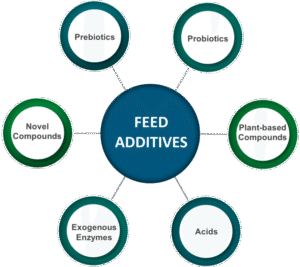Protein
2.1.1. Significance and composition
Protein (from the ancient Greek “protos”: the first or the most important)
is the most important and quantitatively major component
of all organisms and as such is a prerequisite of all life. In feed for
animals, proteins cannot be replaced by any other component.
Protein containing compounds are found in every cell and account
for the major proportion of organisms. They are essential
for maintenance, growth and reproduction of the whole organism.
However they can only fulfil this role in association with other nutrients
which provide energy, with vitamins, minerals, both macro
and trace amounts and water.
The major elements in protein are carbon (C), oxygen (O) and
hydrogen (H) the same as in fats and carbohydrates. In addition
proteins contain nitrogen (N) and sometimes sulphur (S) and
phosphorous (P) (Table 1).
Table 1 – Proportion of elements in protein sources
Thank you for reading. Don't forget to subscribe & share!
Carbon 51.0 – 55.0
Hydrogen 6.5 – 7.3
Oxygen 15.5 -18.0
Nitrogen 0.5 – 2.0
Sulphur 0.5 – 2.0
Phosphorous 0 – 1.5
The proportion of elements in protein sources is relatively constant
(%).
Proteins are high molecular weight, modular compounds. The
modular nature is part of the chemical structure since each protein
is made up of approximately 20 different amino acids. This unique
structure which consists of amino acids in particular sequences
gives to each protein a high degree of specificity with respect to
the function which each individual protein performs. For example,
enzymes are proteins with catalytic function whilst immune bodies
display a defence function. Muscle protein enables animals to
undertake physical work, and bone, skin and connective tissues
have a supportive and protective function. However in animal production,
the primary target is for the animal to produce protein
which is the major essential component of meat, milk and eggs.
The series of amino acids within the protein molecule is genetically
predetermined and referred to as the amino acid sequence.
The amino acids are linked by peptide bonds between the carboxyl
group of the one and the amino group of the next amino
acid. A peptide chain can comprise up to several thousand amino
acids and since there are only approximately 20 different amino
acids, many will be repeated in the peptide chain.
2.1.2. Classification
Proteins can be classified into three groups according to their
structure and solubility:
— Sclero-proteins; which have a fibrous structure and do not
dissolve in water. They are comprised of a long linear chain
as a supportive and paraplastic substance. Typical examples
are collagen (connective tissue, cartilaginous substance) and
keratin (skin, hair, wool, feathers).
— Sphero-proteins; which are essentially firmly intertwined and
soluble in water or dilute saline. This group comprises albumins,
globulins, histones, prolamines and glutelines.
— Proteides; which are made up of proteins but also contain a
non-protein prosthetic group which tends to be firmly bound to
the protein. Depending on the type of prosthetic group, proteides
are:
• Metalloproteins (e.g. haemoglobin)
• Phosphoproteins (e.g. casein)
• Lipoproteins (e.g. serum lipoproteins)
• Nucleoproteins (e.g. nucleic acid + protein)
• Glycoproteins (e.g. seromucoids)
• Chromoproteins (e.g. myoglobin)
The type of binding between the protein portion and the prosthetic
group differs according to the type of prosthetic group and each
different type of proteide has a different function in the organism.
Apart from the proteins already mentioned, compounds containing
nitrogen but with a non-protein nature are also found in animal
tissues. These compounds include alkaloids, amides (asparagine,
glutamine, and urea), betaine, choline and purines. They
are grouped together as non-protein nitrogen (NPN) compounds.
From the point of view of the fundamentals of nutrition, amino
acids are equivalent to proteins. It is primarily for this reason that
the main emphasis in the nutrition of animals has shifted from a
focus on protein as a whole to a focus on individual amino acids.









